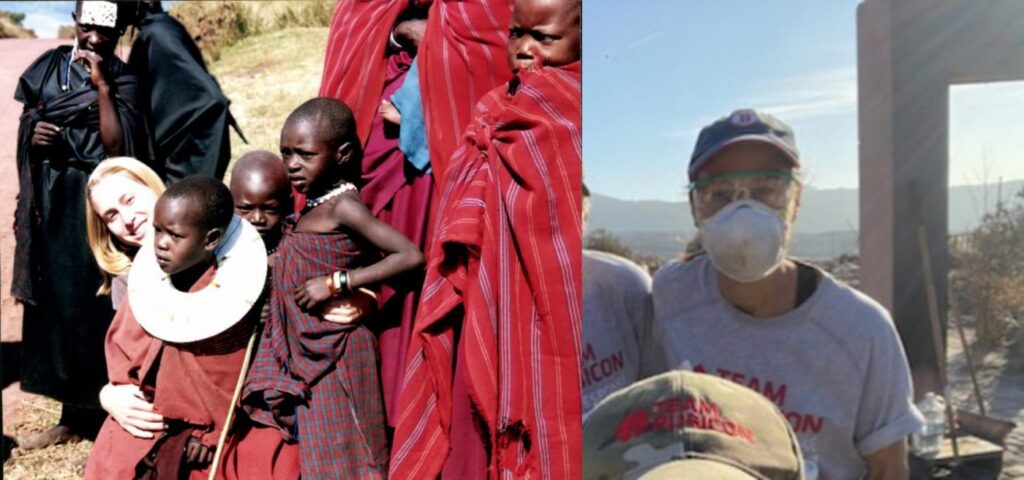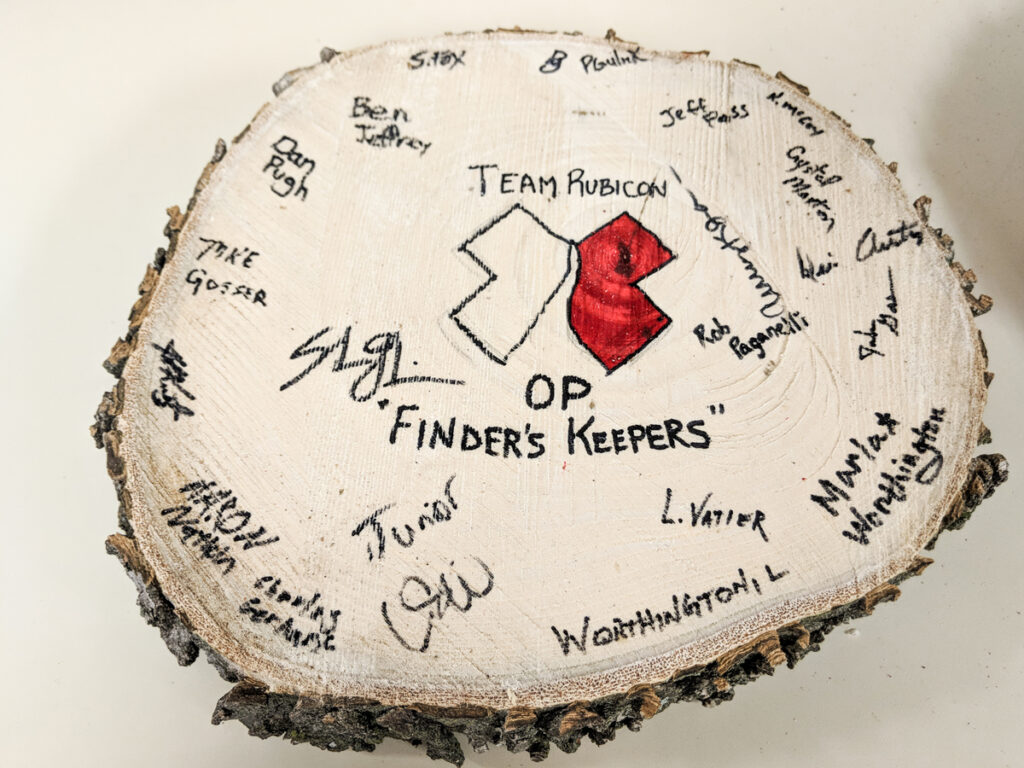Service to country is as American as apple pie. For Team Rubicon, that means many volunteers have spent their Independence Day serving. Some Greyshirts have been deployed with Team Rubicon on the 4th of July; some have been deployed on service projects around the world; many have been deployed with the military. Here are some of their stories.
Cleaning Up After Twin Twisters in Small Town America
Of Team Rubicon’s nearly 50 disaster responses that have fallen on Independence Day, one stands out for Sarah Russell Gamblin-Luig: Finders Keepers, a tornado response in Eureka, Kansas in 2018. What made the response so unique was that Team Rubicon had been to the town two years prior, also responding to a tornado.
“Both tornado paths end up making an X right on top of this tiny town in Kansas,” says Gamblin-Luig, who served as the incident commander on Finders Keepers.
While the operation officially demobilized on July 4, the whole of it was an example of Americana. Greyshirts were the recipient of countless homemade goods from local citizens. And, most impressively, Gamblin-Luig got to play witness to survivors of the first tornado mentoring survivors of the second.

“There was an epicenter where the overlap for both tornadoes hit the same spot, but for the most part, there were a lot of separate people who were affected the second time,” says Gamblin-Luig. “People from the first time we’re able to kind of talk them through the process and give them a shoulder to lean on because they understood. They had just gone through it two years prior.”
In the demob process Gamblin-Luig found the town’s emergency manager in a park, celebrating the 4th with a picnic. She jokingly told him not to call again, because of course, no one wants to see multiple tornadoes in one small town. Then, she was on her way, driving a rental truck back to St. Louis, MO, on Independence Day.
Strumming Springsteen in Sub-Saharan Africa
Greyshirt Kym Kierman had just deployed to Malawi, in sub-Saharan Africa, with the Peace Corps on July 4, 1995. It was her first Fourth of July holiday overseas, her first time in the southern hemisphere, and what would be her last night embedded in her own culture for two years. She was 21 years old, had been in country for four days, and was preparing to head to a remote village where she would spend the next three months in total immersion training, then two years working in public health, specifically focusing on maternal and child health, with an emphasis on HIV/STD education and prevention.
“It was terrifying, to say the least,” chuckles Kierman. But that night—the American volunteers’ last night together— a guitar came out and soon the sound of Crosby, Stills & Nash’s “Southern Cross” filled the sub-Saharan air, followed by Bruce Springsteen’s “Born in the USA” to celebrate Independence Day back home. “It was a bit of a cheesy moment, but certainly a 4th of July time I will never forget.”
That time serving in Africa led to Kierman’s joining Team Rubicon, too. “As a Peace Corps volunteer I felt like I was a part of something bigger than me; a part of an organization that was making a difference,” she says. So, when she returned to the US in 1997, she began volunteering extensively on the East Coast with several organizations—including the American Red Cross—then with Team Rubicon after moving to California in 2007.

“I just felt like it filled the gap I was feeling and is giving me that opportunity to do meaningful volunteer work, give back to people in their time of need, and to feel a part of something bigger than me again,” says Kierman.
In between the Peace Corps and earning her grey shirt, Kierman returned to Africa for another Independence Day. Seven years after that first week in Malawi she was in Tanzania, climbing Mount Kilimanjaro to raise money for a charity she had just started. She summited on July 4th, 2002.
“This was the first Fourth of July after 9/11,” says Kierman. “I had had no contact with the outside world for six days at that point, and I remember sitting atop Mount Kilimanjaro wondering if our country had been attacked again on its first Independence Day after 9/11.” Three days later, back at sea level, she got word that all was well back at home.
Melted Ice Cream, Near Beer, and Fireworks Over Zakho
Greyshirt Keith Gardner was one of those serving with the military on an Independence Day. In the early ’90s Gardner had been stationed as a Combat Camera Team Chief with the Army in Hohenfels, Germany. In ’91 he was tasked with deploying an ad hoc combat camera team as part of a joint combat camera unit in support of Operation Gallant Provider/Provide Comfort in Northern Iraq. As the mission wound down, Gardner was asked to stay behind and bat clean up. So, Gardner redeployed his 5th Corps and Combat Maneuver Training Center troops and went to work with the rear echelon Air Force element—bringing them forward from Incirlik Airforce Base in Turkey to Zakho, Iraq.
On July 4, 1991, Gardner spent the day with Psychological Operations—now known as Military Information Support Operations, or MISO—spreading the word to the Kurds that the Americans were going to shoot off their own “celebratory fire” in hopes of maintaining the peace—and ensuring they didn’t think something else was up.
It was 135 degrees in Sarsink, Iraq that day, but after he’d spent it notifying the Kurds about the American’s plans, Gardner was back in Zakho in time for Chinook helicopters to drop off the celebratory goods for the Americans—melted ice cream, trash bags filled with popcorn, and one can of “room temperature” near-beer for each service member.
“We were treated to a pretty good fireworks display given the circumstances,” says Gardner. “And of course, it was accompanied by a rash of small firefights up in the hills.”
That Independence Day celebration was capped off with a broadcast via AFN satellite dish of the Times Square parade.
“I couldn’t believe my eyes when I saw one of my Hohenfels Desert Shield/Desert Storm veterans carrying Old Glory down Broadway. It took all my efforts to choke back the tears on that day of days,” explains Gardner. “In my 20-plus years in the military, I spent many an Independence Day deployed—at Basic, AIT, on two tours in Korea, a year in the Sinai, two more years in that Germany tour, plus Bosnia and Kosovo. But, it was that one day in Iraq 30 years ago, watching a fellow veteran from Desert Shield march down Broadway carrying the flag, that’ll live in my heart forever.”




